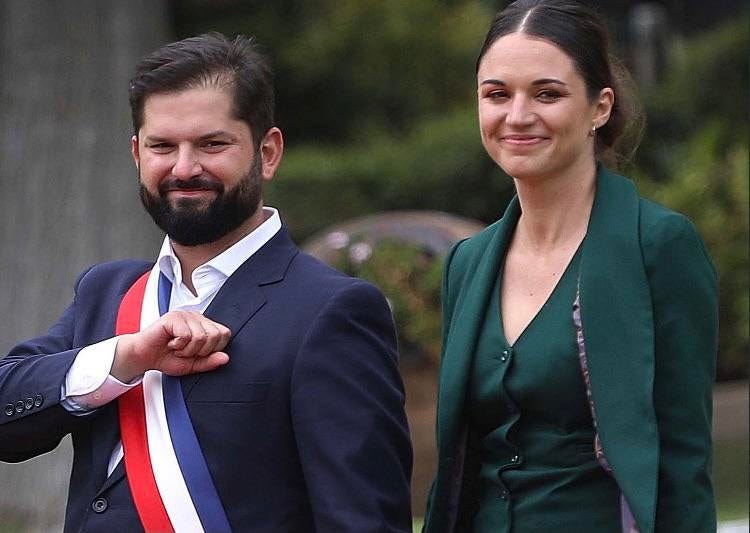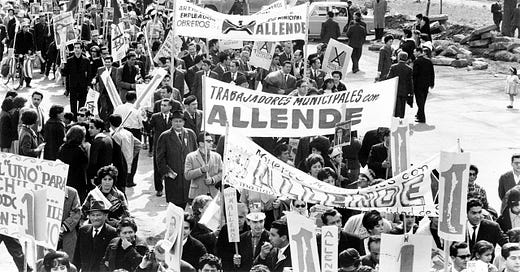Good morning, subscriber!
“Here at the end of all things,” Frodo says to Sam as (spoiler alert) Mount Doom crumbles around them, “I am glad you are here with me.” And here, at the beginning of August, loyal reader, as the US crumbles around us, I’m glad you’re here with me. In fact, I’m so glad that today I thought I’d write with some good news, out of Chile.
In March, Gabriel Boric, at 36 years old, became the youngest president in the country’s history. In the election last year, Boric soundly defeated José Antonio Kast, an ultraconservative, pro-business, law-and-order Catholic who opposed abortion and same-sex marriage and urged voters to “dare to make Chile a great country” (how original). Now, Boric’s cabinet, in a first for Latin America, is predominately female, two ministers are openly gay, and the leftist administration’s agenda focuses on social justice, human rights, and the environment. It gets better: Boric’s partner, Irina Karamanos, a thirty-two-year-old feminist with degrees in anthropology and education, declared that she would “reformulate” the role of First Lady because she was “neither first nor a lady.” In other words, Boric and Karamanos are like the Bidens if you halved their ages and gave them progressive lobotomies.1

And also, if you stacked the decks against them. In the 70s and 80s, the US helped usher in a wave of repression and plundering in Chile that led to the deaths of thousands of people and pushed the country to the brink of economic collapse. This horrible period was especially distressing given the promise of Salvador Allende’s presidency just before. Boric is the only person to win more votes for president than Allende in Chile’s history, and at the risk of pinning too many Frodo-like hopes on one administration, his ascent is an encouraging signal that misguided policies of the past might yet be reversed.
To see what I mean, let’s head back to the Nixon years.

After World War II, you might recall from other bits of Skipped History that the US was cuckoo for coup-coup attempts. On orders from Eisenhower, JFK, and LBJ, the CIA spurred regime change in Iran (1953), Guatemala (1954), Brazil (1964), Indonesia (1965), and a host of other countries. Under Nixon, this cycle “continued apace,” writes historian Greg Grandin, particularly in Latin America, where his administration aided the toppling of democratic governments in Uruguay, Ecuador, and Bolivia. As Nixon once observed, “Latin America’s had 150 years of trying,” and “they don’t have much going on down there,” so they might as well welcome US-backed leaders “able to run the damn place.” Nixon’s rationale, which sounds less like the description of an entire continent than a predatorial entrepreneur trying to take over a mismanaged Olive Garden, faced an unparalleled obstacle in Salvador Allende.2

Born into an upper-class family in Santiago in 1907, Allende was a Marxist intellectual who enjoyed sipping red wine in silk tweed jackets. In other words, he didn’t look like a revolutionary, but he acted like one. In 1933, he helped found Chile’s modern Socialist Party, and after becoming a congressman, and later minister of health, he worked on programs that increased pensions for widows, provided prenatal care for women, and introduced workplace safety regulations. In the 50s, as a senator, he authored a bill to build classrooms and hire teachers with the goal of turning Chile “into one big school,” aka my dream political platform. As the literacy rate went up, so too did Allende’s popularity. After running for president three times, on his fourth try, in 1970, 63% of the electorate voted him into power. One Chilean leftist recalls that Allende’s victory brought “hope and joy, even spiritual ecstasy,” and she was convinced, just as many Chileans were, “that we were going to change the world.”3

Nixon and Secretary of State Henry Kissinger feared the same thing. In fact, unlike what US students often learn, the Nixon administration “saw Allende as being a far more serious threat than [Fidel] Castro,” one staffer later remarked. Why? Because unlike Castro, who was busy installing a dictatorship, Allende pursued a peaceful “Chilean way” to socialism and “was a living example of democratic social reform.” The horror! So, even before Allende was elected, Washington began spending millions of dollars to destabilize Chile and prod its military to act.4
A conservative group of Chilean economists, nicknamed the Chicago Boys, welcomed US meddling. In a special program from 1957 to 1970, the Chicago Boys trained in the right-wing, free market economics department at the University of Chicago. Afterward, they returned to Chile to set up free-market think tanks funded by US corporate money. As one of the Chicago alumni attested, they viewed their mission of privatizing healthcare, education, Olive Gardens—just about any and everything—as an existential quest against Allende’s “ideological positions which... perpetuated poverty and backwardness.” The two million or so people who voted for Allende likely disagreed with this assessment. Still, the Chicago Boys assured the military they had a superior economic plan ready just in case Allende should fall.5
Lo and behold, in September 1973, a military junta announced that “after three years of supporting the Marxist cancer,” they considered themselves “obligated to act.”



